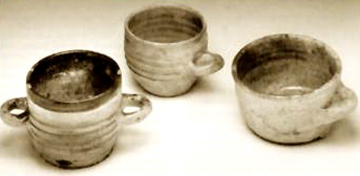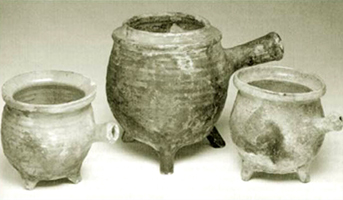Examples of Border Ware Vessel Forms
Porringers
 A porringer is a circular vessel, shaped like a small bowl or large cup, with one or two horizontal, rather than vertical, handles. Border ware porringers occur in archaeological assemblages in London from the late 16th century (Pearce 1992). They are typically groove-incised at or just below the mid-point of the profile (although the late 17th-century trend toward simplicity of style partially eradicated this practice). The majority of Border ware porringers are also ribbed around the upper body, above the carination.
A porringer is a circular vessel, shaped like a small bowl or large cup, with one or two horizontal, rather than vertical, handles. Border ware porringers occur in archaeological assemblages in London from the late 16th century (Pearce 1992). They are typically groove-incised at or just below the mid-point of the profile (although the late 17th-century trend toward simplicity of style partially eradicated this practice). The majority of Border ware porringers are also ribbed around the upper body, above the carination.
Porringers were used for food consumption, so they are commonly glazed on the interior. In the case of Border ware porringers, the glaze often extends slightly over the rim edge. It is unknown whether this was done on purpose or whether it is a result of careless splashing. Most white Border ware porringers are glazed yellow. Some are glazed green; brown glaze and red ware forms appear only in the mid 17th century. Many Border ware porringers also exhibit a thin, glossy glaze on the exterior surfaces.
Pearce’s (1992) study revealed that the early 17th century witnessed a noticeable increase in the number of Border ware porringers found in London’s households. At this time, they displayed a standard corrugated profile with a ribbed upper margin. By the end of the 17th century, plain-walled and slightly ribbed vessels became more prominent.
Tripod Pipkins
 A tripod pipkin, a common Border ware form, is a round- to pear-shaped cooking vessel with three support legs and at least one handle. The amount and prominence of ribbing, as well as body width, may possibly serve as chronologically diagnostic indices.
A tripod pipkin, a common Border ware form, is a round- to pear-shaped cooking vessel with three support legs and at least one handle. The amount and prominence of ribbing, as well as body width, may possibly serve as chronologically diagnostic indices.
The tripod pipkin form exhibits internal and external ‘steps’ to accommodate the fitting of a lid. The location of the step may also facilitate dating of the vessel: external lids were a later addition and most likely were an improvement in design to accommodate a tighter fitting lid that was more capable of preventing both heat loss and spillage.
That the tripod pipkin form was used in food preparation is evidenced by the fact that over 75 percent of the samples recovered from London (Pearce 1992), as well as the total sample from Port Royal, show partial scorching or burning. Most tripod pipkins are glazed yellow. Some may show a mixed yellow/green glaze; fewer are green glazed. Glaze was applied exclusively to the interior of these forms.
Chamber Pots
 Pearce (1992) distinguishes Border ware chamber pots by dividing them into two general types, based on overall shape, rim form, and glaze color: Type 1, an earlier form, characterized by its rounded shape, and shown opposite left, usually has an everted rim and is commonly glazed yellow on the interior only. The later Type 2 form (opposite right) is noticeable squatter than Type 1. Rims are broad and generally flat-topped, and glazes, which are applied on both the interior and exterior surfaces, are predominantly green.
Pearce (1992) distinguishes Border ware chamber pots by dividing them into two general types, based on overall shape, rim form, and glaze color: Type 1, an earlier form, characterized by its rounded shape, and shown opposite left, usually has an everted rim and is commonly glazed yellow on the interior only. The later Type 2 form (opposite right) is noticeable squatter than Type 1. Rims are broad and generally flat-topped, and glazes, which are applied on both the interior and exterior surfaces, are predominantly green.
BIBLIOGRAPHIC SOURCES
HAMILTON, D. L. 1992. Simon Benning, Pewterer of Port Royal. In Text-Aided Archaeology, edited by B. J. Little, pp.39-53. CRC Press, Boca Raton, Florida.
NOEL HUME, I. 1980. A Guide to Artifacts of Colonial America. Alfred A. Knopf, New York.
PEARCE, J. 1992. Post-Medieval Pottery in London, 1500-1700: Border Wares. HMSO, London.
THOMPSON, A., F. GREW, and J. SCHOFIELD 1984. Excavations at Aldgate, 1974. Post-Medieval Archaeology 18:1-148.
